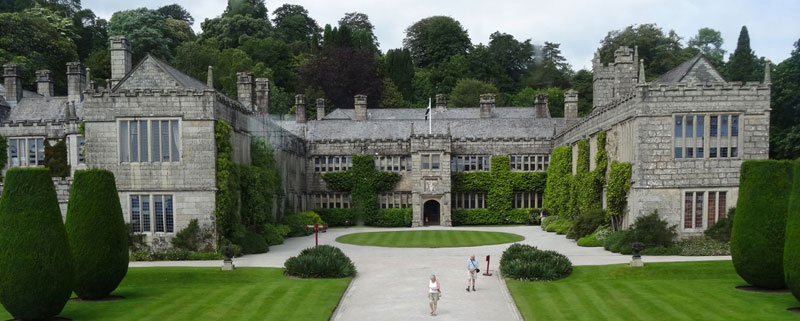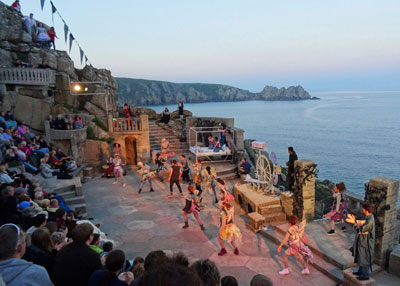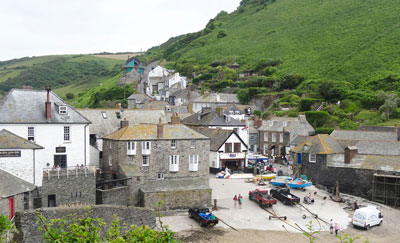Discovering England’s delightful Cornwall region
This article appears on page 44 of the October 2014 issue.
by John Scheleur; Arnold, MD
On Thanksgiving Day, 2013, I saw an ad in ITN from Dacey’s Cornish Tours (St. Paul, MN; 651/484-4689, www.daceyscornishtours.com) for a one-week tour of Cornwall, in the southwest corner of England, that sounded interesting. Founder David Warner, a transplanted Cornishman living in Minnesota, promptly responded to my inquiry with some trip details.
I told David that my wife, Pat, and I were heading from Maryland to Pennsylvania for the weekend and would think it over and get back to him on Monday.
On Saturday, the first out-of-state license plate we saw on Interstate 95 was from Minnesota, 1,109 miles from Minneapolis. After checking into our hotel, we received an email from our son, who had been on a Disney cruise and was telling us how great it had been, especially their waiter, Cornwall! We booked the tour first thing Monday morning.
St. Michael’s Mount
David Warner left Cornwall at age 30, and he returns — along with his business partner, the most charming Harry, from Fowey — to run four tours a year (increasing to seven in 2015). On our tour, they showed 14 people (the maximum tour size) what an amazing place we had overlooked until then.
Twenty years earlier, Pat and I had visited Mont Saint-Michel, off the Normandy coast of France. There we learned of another Benedictine abbey, located on St. Michael’s Mount, a tidal island located off the coast of Cornwall at Penzance. We put it on our list of places to visit one day, and that day had finally arrived.
St. Michael’s Mount was worth the 20-year wait. Accessible at high tide by boat, it lies 400 yards offshore. We found none of the commercialization that mars Mont Saint-Michel (no overpriced omelettes here).
One sign, which read, “The Pilgrim’s Steps,” told it all. The steps, which led to the top of the mount, were a steep climb, but we, in our late 60s, managed OK.
The walk at low tide on the granite paving stones was a real treat. Eat your heart out, Mont Saint-Michel, with your new, ultramodern pedestrian bridge and shuttle buses.
Seaside stops
One tour stop that caused much excitement was the small fishing town of Port Isaac, the setting for the hugely popular PBS series “Doc Martin.” We could easily pick out locations that were familiar from the show.
This also offered our first opportunity to sample two local food items, the Cornish pasty and Cornish ice cream. The pasty, which resembles a turnover filled with meat, potatoes and other items, was once carried into the local tin mines, where it could be eaten with one hand. The ice cream is a frozen version of Cornwall’s clotted cream. We loved the ice cream. The seagulls loved the pasty.
The picturesque town of St. Ives, where we spent two nights, was a surprise to most of our group. The beaches and ocean looked like they belonged in the Caribbean (we read that there are almost 300 beaches in Cornwall) and the gardens were subtropical delights. This town is where the Brits take their holidays, and artists have been going there for years to capture its beauty.
In St. Ives we watched an outdoor evening performance at the incredible Minack Theatre. Sitting in the theater carved into a mountainside, with the Atlantic Ocean as a backdrop, was quite a thrill! How could this exist without us ever hearing about it?
But, then, we didn’t know a lot about Cornwall. Yes, we had heard about Land’s End, but we didn’t know about the stunning cliffs, which were reminiscent of the Connemara area of western Ireland. We were glad the area was on our itinerary.
Grand sights
From the tip of Cornwall, we made our way northeast to find more surprises. The Lost Gardens of Heligan, a 150-year-old botanical garden that fell into ruin, was rediscovered in the early 1990s. One of the largest garden restoration projects in England was undertaken to showcase this subtropical paradise. A favorite attraction for everyone was the amazing mud sculptures there.
Next on our discovery tour was the number-one attraction in Cornwall, the Eden Project, two immense biomes that were constructed in an abandoned clay pit. Designed to show the interdependence of plants and people, it features the world’s largest indoor rainforest. Rainwater is collected for plant watering, and electricity is generated by alternative sources, including a wind turbine.
We made a brief stop next in the stunning seaside town of Fowey (pronounced Foy). Famous as the launch site for many ships on D-Day, it is also the former home of Daphne du Maurier, author of “Rebecca,” “Jamaica Inn” and “The Birds.”
Dacey’s Cornish Tours was not finished yet! What would England be without a Victorian-era home tour? At the National Trust property of Lanhydrock, visitors can see more than 50 rooms, including all of the service areas, offering a great glimpse of life “below stairs.” Fans of the “Downton Abbey” television series should know that the folks at Lanhydrock provided expert advice on Victorian table settings after viewers complained that the BBC had it all wrong.
The volunteer staff were extremely well versed and helpful. We now know what a sluice room is and why it was the one area in which male and female staff could discreetly exchange conversation during the day. (Go ahead and Google it. We’ll wait.)
The details
When considering any organized tour, most travelers are interested in the scheduled accommodations. Well, I have to admit, I never asked. The company’s website mentioned 3-star or better accommodations, and we are easy to please. Indeed, we were very pleased!
We stayed in two historic manor homes, The Longcross Hotel and Trenython Manor. Each had large rooms, with excellent breakfasts included, and a restaurant and bar on site.
Everyone loved the two nights we spent at Tregenna Castle Hotel, situated high above the beaches of St. Ives. Built in 1774, it offered indoor and outdoor pools, hot tubs, golfing and tennis.
Our hotel in London, where we assembled on the night before our tour, was the Lancaster Gate Hotel, next to Hyde Park, where David and Harry led a group of us on a Sunday walk.
Which brings me to an important part of this tour. As most are aware, the Brits love to walk, and David and Harry carry on that tradition well. There was a lot of walking on this tour, and this area of England is quite hilly. Most of our group were fine with it, but no one needed rocking to sleep at night.
The cost of the one-week tour was $1,365 per person, double. On the company’s website, David spells out the type of tour he operates, namely a “stress-free adventure,” which ours certainly was. Everything went like clockwork.
Our van driver, Tim, was incredible. Driving the narrow roads in Cornwall is a challenge only a Cornishman can navigate so superbly.
The company’s motto is “The adventure is yours. We’re just here to make sure nothing gets in the way.”
Cornwall was a most enjoyable discovery for us and remains a memorable one!



